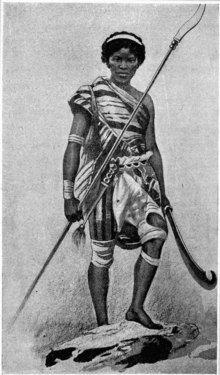
Back Fon (volk) Afrikaans شعب فون Arabic Foned Breton Fon (grup humà) Catalan Fonové Czech Fon (Volk) German Fonoj Esperanto Pueblo fon Spanish Fonid Estonian Fon Basque
 "Dahomey Amazon" by Élisée Reclus (1905) | |
| Total population | |
|---|---|
| 5 million (including related groups like; Gun, Mahi, Ayizo, Weme)[1] | |
| Languages | |
| Fon, French | |
| Related ethnic groups | |
| Other Gbe peoples |
| Person | Fon |
|---|---|
| People | Fon-nu |
| Language | fɔ̀ngbè |
| Country | Dahomey |
The Fon people, also called Fon nu, Agadja or Dahomeans, are a Gbe ethnic group.[2][3] They are the largest ethnic group in Benin found particularly in its south region; they are also found in southwest Nigeria and Togo. Their total population is estimated to be about 3,500,000 people, and they speak the Fon language, a member of the Gbe languages.[2][4]
The history of the Fon people is linked to the Dahomey kingdom, a well-organized kingdom by the 17th century but one that shared more ancient roots with the Aja people.[3] The Fon people traditionally were a culture of an oral tradition and had a well-developed polytheistic religious system.[5] They were noted by early 19th-century European traders for their N'Nonmiton practice or Dahomey Amazons – which empowered their women to serve in the military, who decades later fought the French colonial forces in 1890.[6][7]
Cities built by the Fon include Abomey, the historical capital city of Dahomey on what was historically referred to by Europeans as the Slave Coast. These cities became major commercial centres for the slave trade. A significant portion of the sugar plantations in the French West Indies, particularly Haiti, Suriname and Trinidad were populated with slaves that came from the Slave Coast, through the lands of Ewe and Fon people.[8]
- ^ a b Fon people, Encyclopædia Britannica, undated, 1.7 million population, Retrieved June 29, 2019
- ^ a b Elizabeth Heath (2010). Anthony Appiah; Henry Louis Gates (eds.). Encyclopedia of Africa. Oxford University Press. pp. 482–483. ISBN 978-0-19-533770-9.
- ^ III, John A. Shoup (2011). Ethnic Groups of Africa and the Middle East: An Encyclopedia: An Encyclopedia. ABC-CLIO. ISBN 978-1-59884-363-7.
- ^ Molefi Kete Asante; Ama Mazama (2009). Encyclopedia of African Religion. Sage Publications. pp. 270–273, 257, 412. ISBN 978-1-4129-3636-1.
- ^ Robin Law (1993), The 'Amazons' of Dahomey, Paideuma: Mitteilungen zur Kulturkunde, Bd. 39 (1993), pp. 245–260
- ^ Alpern, Stanley B. (1998). "On the Origins of the Amazons of Dahomey". History in Africa. 25. Cambridge University Press: 9–25. doi:10.2307/3172178. JSTOR 3172178. S2CID 162412301.
- ^ Cite error: The named reference
TaylorCase2013p742was invoked but never defined (see the help page).
© MMXXIII Rich X Search. We shall prevail. All rights reserved. Rich X Search